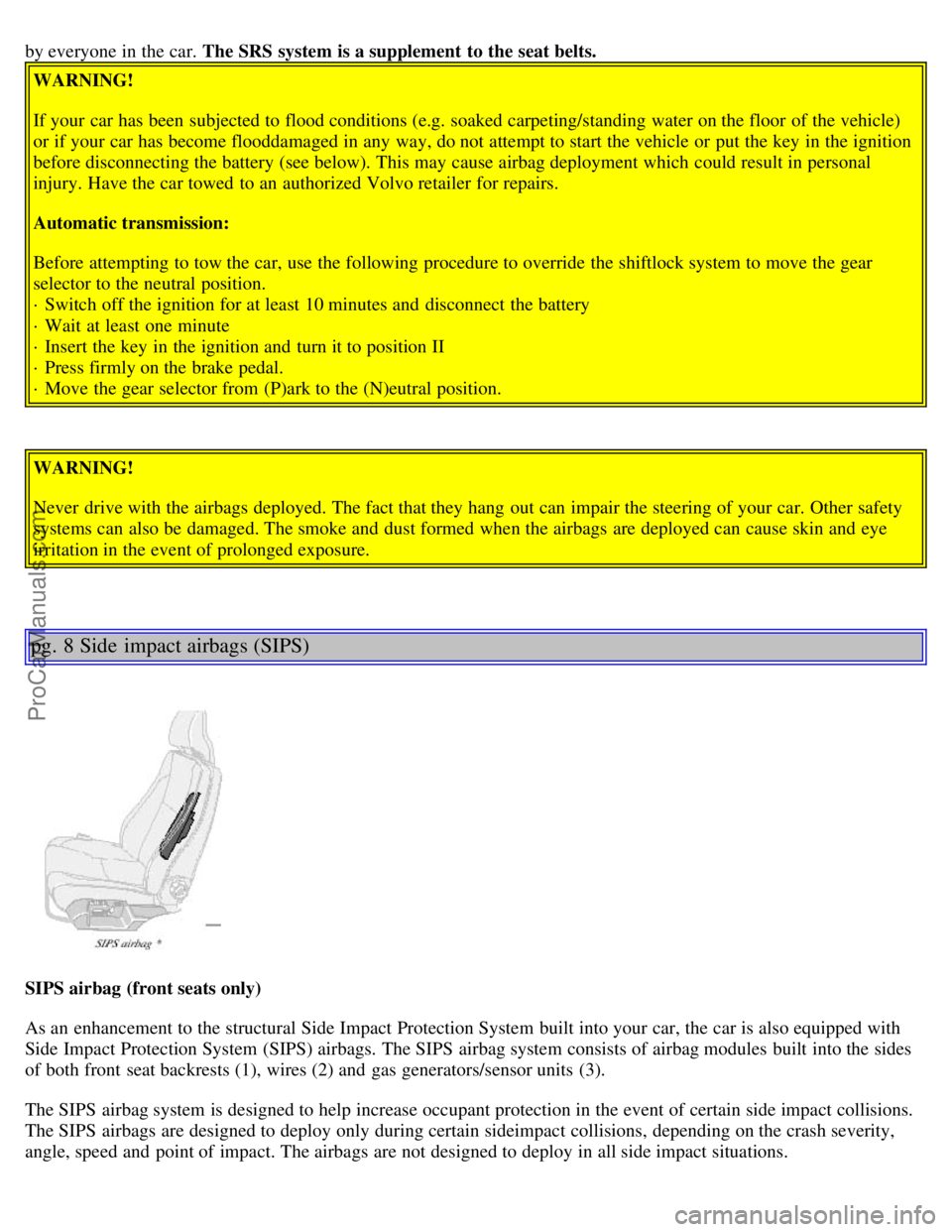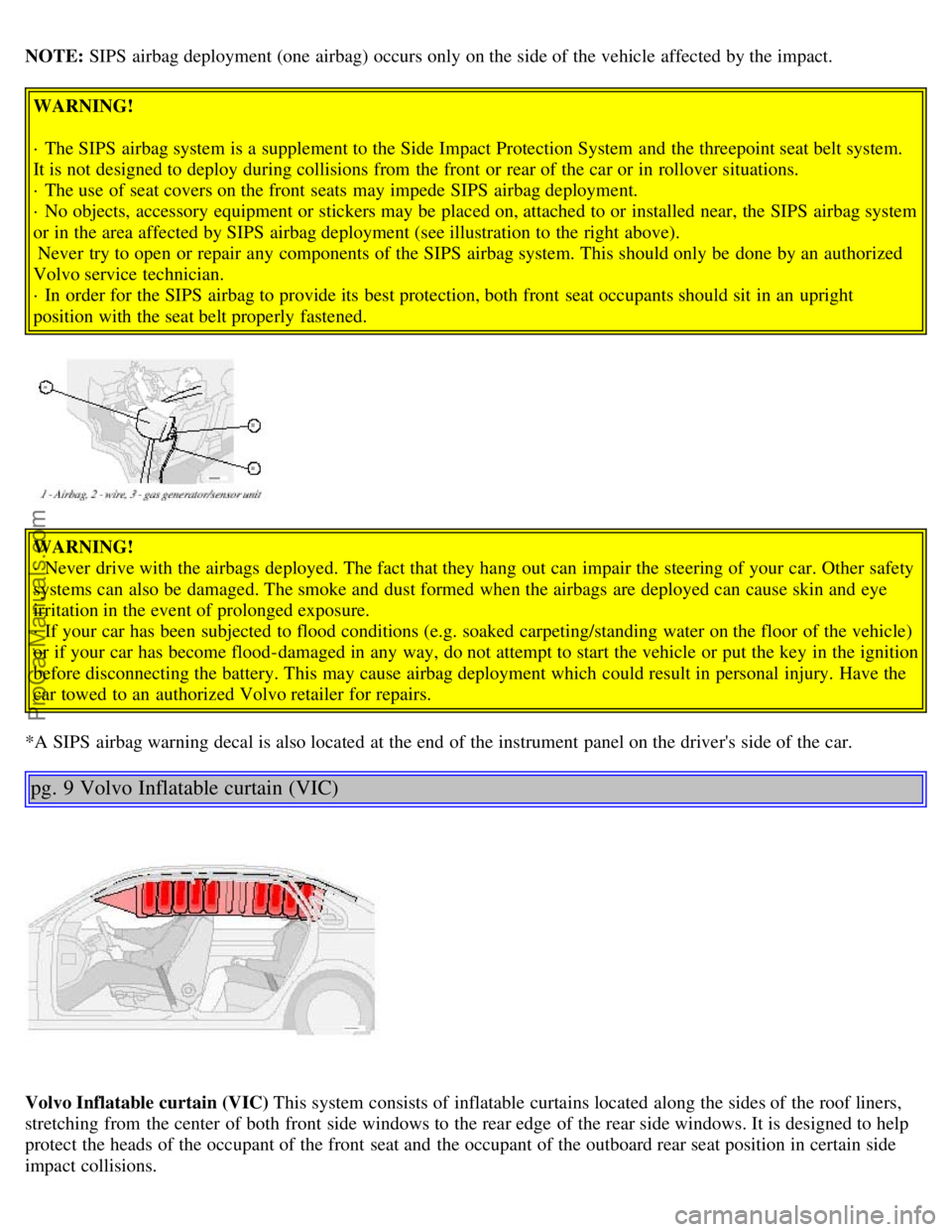2001 VOLVO S80 belt
[x] Cancel search: beltPage 12 of 106

by everyone in the car. The SRS system is a supplement to the seat belts.
WARNING!
If your car has been subjected to flood conditions (e.g. soaked carpeting/standing water on the floor of the vehicle)
or if your car has become flooddamaged in any way, do not attempt to start the vehicle or put the key in the ignition
before disconnecting the battery (see below). This may cause airbag deployment which could result in personal
injury. Have the car towed to an authorized Volvo retailer for repairs.
Automatic transmission:
Before attempting to tow the car, use the following procedure to override the shiftlock system to move the gear
selector to the neutral position.
· Switch off the ignition for at least 10 minutes and disconnect the battery
· Wait at least one minute
· Insert the key in the ignition and turn it to position II
· Press firmly on the brake pedal.
· Move the gear selector from (P)ark to the (N)eutral position.
WARNING!
Never drive with the airbags deployed. The fact that they hang out can impair the steering of your car. Other safety
systems can also be damaged. The smoke and dust formed when the airbags are deployed can cause skin and eye
irritation in the event of prolonged exposure.
pg. 8 Side impact airbags (SIPS)
SIPS airbag (front seats only)
As an enhancement to the structural Side Impact Protection System built into your car, the car is also equipped with
Side Impact Protection System (SIPS) airbags. The SIPS airbag system consists of airbag modules built into the sides
of both front seat backrests (1), wires (2) and gas generators/sensor units (3).
The SIPS airbag system is designed to help increase occupant protection in the event of certain side impact collisions.
The SIPS airbags are designed to deploy only during certain sideimpact collisions, depending on the crash severity,
angle, speed and point of impact. The airbags are not designed to deploy in all side impact situations.
ProCarManuals.com
Page 13 of 106

NOTE: SIPS airbag deployment (one airbag) occurs only on the side of the vehicle affected by the impact.
WARNING!
· The SIPS airbag system is a supplement to the Side Impact Protection System and the threepoint seat belt system.
It is not designed to deploy during collisions from the front or rear of the car or in rollover situations.
· The use of seat covers on the front seats may impede SIPS airbag deployment.
· No objects, accessory equipment or stickers may be placed on, attached to or installed near, the SIPS airbag system
or in the area affected by SIPS airbag deployment (see illustration to the right above).
Never try to open or repair any components of the SIPS airbag system. This should only be done by an authorized
Volvo service technician.
· In order for the SIPS airbag to provide its best protection, both front seat occupants should sit in an upright
position with the seat belt properly fastened.
WARNING!
· Never drive with the airbags deployed. The fact that they hang out can impair the steering of your car. Other safety
systems can also be damaged. The smoke and dust formed when the airbags are deployed can cause skin and eye
irritation in the event of prolonged exposure.
· If your car has been subjected to flood conditions (e.g. soaked carpeting/standing water on the floor of the vehicle)
or if your car has become flood-damaged in any way, do not attempt to start the vehicle or put the key in the ignition
before disconnecting the battery. This may cause airbag deployment which could result in personal injury. Have the
car towed to an authorized Volvo retailer for repairs.
*A SIPS airbag warning decal is also located at the end of the instrument panel on the driver's side of the car.
pg. 9 Volvo Inflatable curtain (VIC)
Volvo Inflatable curtain (VIC) This system consists of inflatable curtains located along the sides of the roof liners,
stretching from the center of both front side windows to the rear edge of the rear side windows. It is designed to help
protect the heads of the occupant of the front seat and the occupant of the outboard rear seat position in certain side
impact collisions.
ProCarManuals.com
Page 14 of 106

NOTE: IC system deployment occurs only on the side of the vehicle affected by the impact.
In certain side impacts, BOTH the Inflatable Curtain (IC) and the Side Impact Airbag System (SIPS-bag) will deploy,
whereas, in some cases, ONLY the Inflatable Curtain (IC) will deploy. In cases where BOTH the IC and the SIPS -bag
deploy, deployment will occur simultaneously.
If the inflatable curtain deploys, it remains inflated for approximately 3 seconds.
WARNING!
· The IC system is a supplement to the Side Impact Protection System. It is not designed to deploy during collisions
from the front or rear of the car or in most rollover situations.
· Never try to open or repair any components of the IC system. This should only be done by an authorized Volvo
service technician.
· The inflatable curtains are designed to deploy only during certain sideimpact collisions, depending on the crash
severity, angle, speed and impact. The inflatable curtains are not designed to deploy in all side impact situations.
· For best protection from the IC, both front seat occupants and both outboard rear seat occupants should sit in an
upright position with the seat belt properly fastened; adults using the seat belt and children using the proper child
restraint system. Only adults should sit in the front seats. Children must never be allowed in the front passenger seat.
See page 14
for guidelines. Failure to follow these instructions can result in injury to the vehicle occupants in an
accident.
Contents | Top of Page
ProCarManuals.com
Page 51 of 106

Starting the engine
1. Fasten the seat belt.WARNING!
Before starting, check that the seat, steering wheel and mirrors are adjusted properly. Make sure the brake pedal can
be depressed completely. Adjust the seat if necessary. See page 48
.
2. Apply the parking brake, if not already set. The gear selector is locked in the (P)ark position (SHIFTLOCK).
3. Without touching the accelerator pedal, turn the ignition key* to the starting position. Allow the starter to operate
for up to 5 seconds (turbo: 10 seconds). Release the key as soon as the engine starts. If the engine fails to start, repeat
this step.
For cold starts at altitudes above 6000 ft (1800 meters), depress the accelerator pedal halfway and turn the key to the
starting position. Release the pedal slowly when the engine starts.
4. To release the gear selector from the (P)ark position, the engine must be running (or the ignition key must be in
position II) and the brake pedal must be depressed.
5. Select the desired gear. The gear engages after a very slight delay which is especially noticeable when selecting R.
NOTE:
· Your car is equipped with a KEYLOCK system. When the engine is switched off, the gear selector must be in the
( P )ark position before the key can be removed from the ignition switch.
· When starting in cold weather, the transmission may shift up at slightly higher engine speeds than normal until the
automatic transmission fluid reaches normal operating temperature.
CAUTION :
· The engine should be idling when you move the gear selector. Never accelerate until after you feel the transmission
engage! Accelerating immediately after selecting a gear will cause harsh gear engagement and premature transmission
wear.
· Selecting P or N when idling at a standstill for prolonged periods of time will help prevent overheating of the
automatic transmission fluid.
· Do not race a cold engine immediately after starting. Oil flow may not reach some lubrication points fast enough to
prevent engine damage.
WARNING!
· Always place the gear selector in Park and apply the parking brake before leaving the vehicle. Never leave the car
unattended with the engine running.
· Always open the garage doors fully before starting the engine inside a garage to ensure adequate ventilation. The
exhaust gases contain carbon monoxide, which is invisible and odorless but very
poisonous.
* Your car is equipped with an electronic start inhibitor (immobilizer). The keys you received with your car are
specially coded. The code in the key is transmitted to an antenna in the ignition switch where it is compared to the
code stored in the start inhibitor module. The car can only be started if a properly coded key is used.
ProCarManuals.com
Page 66 of 106

2 0 0 1
VOLVO S80
Chapter 8 - Maintenance/Servicing
pg.91 Maintenance/Servicing
Fuses92
Replacing bulbs96
Paint touch up103
Washing the car104
Cleaning the upholstery105
Maintenance service, Warranty106
Maintenance schedule107
Fuel/emissions systems109
Drive belt, Air pump system, Coolant110
Servicing111
Opening the hood, Engine compartment113
Engine oil114
Power steering/Brake fluid reservoirs116
Battery maintenance117
Replacing wiper blades119
pg.92 Fuses
ProCarManuals.com
Page 100 of 106

Cup holder - opening..........52
D
Dimensions..........123
Direction indicator bulbs (front)..........97
Direction indicators..........31
Distributor ignition system..........126
Door step courtesy lights - replacing..........100
Doors and locks..........56
Drive belt..........110
Driving economy..........71
Driving mode indicator..........23
Driving mode W..........68, 70, 80
Driving with trunk open..........72
E
Economical driving..........71
Electrical system..........127
Electrical system - general information..........72
Electrically operated front seats..........48
Electrically operated sideview mirrors..........36
Electrically operated sun roof..........37
Electrically operated windows..........35
Electronic Brake Force Distribution..........17
Electronic Climate Control
(ECC)..........41, 42, 43, 45
Emergency Locking Retractor (ELR)..........14
Emergency towing..........74, 75
Emergency warning flashers..........33
Emissions systems..........109
Engine - specifications..........124
Engine - starting..........66
Engine compartment..........113
Engine oil..........64, 80, 114, 115, 125
Exterior courtesy lights..........56
Exterior features - overview..........21
F
Fog light - rear..........25
, 30
Fog lights - front..........30
Folding head restraints..........27
Folding passenger's seat backrest..........49
Folding rear seat backrests ........54
Folding sideview mirrors..........27
Front airbags - SRS..........4-7
Front airbags - SRS - warning light..........24
Front courtesy lights - replacing..........102
ProCarManuals.com
Page 103 of 106

P
Paint touch-up..........103
Panic function (alarm)..........60
Parking brake..........34
Parking brake reminder light..........24
Parking lights..........30
Passenger's seat backrest - folding..........49
Polishing..........105
Power seats..........48
Power steering - speed-sensitive..........72
Power steering fluid ........ 116, 125
Power windows..........35
PROPOSITION 65 WARNING..........117
R
Reading lights - front/rear ........ 50
Rear door step lights - replacing..........100
Rear fog light..........25, 30
Rear reading lights..........50
Rear seat backrests - folding..........54
Rear suspension..........126
Rear window - heated..........33
Rearview mirror..........36
Refrigerant..........44, 125
Refueling..........65
Remote control - keyless entry system..........57
Remote keyless entry system..........57
Remote keyless entry system - replacing batteries..........58
Replacing bulbs..........96-102
Replacing fuses..........92
Replacing wiper blades..........119
Reporting safety defects..........11
Road assistance..........128
Roadholding..........72
Roof load - maximum..........123
Roof racks..........73
S
Safety defects - reporting..........11
Safety locks - child..........62
Seat belt maintenance..........11
Seat belts..........2, 3, 14
Seat belts - cleaning..........105
Seats - front..........48
Servicing..........111, 112
Shiftlock..........66, 67, 69
ProCarManuals.com